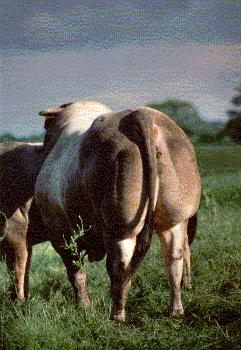
Bazas, an ancient and historic town situated between the Bordeaux vineyards and the Landaise forest in South West France, has given its name to a breed of cattle: Bazadaise (pronounced Baz-A-Day). Known since the Middle Ages, this grey animal with its light coloured muzzle, was used for all agricultural and forest work. This suitability for work, its hardiness and adaptability, its toughness and vigour even in the most extreme conditions (heat, sloping ground etc.) plus its excellent fattening qualities lift the Bazadaise into the best of meat producers.
At that time, the cows used to produce one calf a year destined to be butchered, whilst a few males, castrated very young, worked until they were seven or eight years old and then ended their life as fat beef. The Herd Book was started in 1896 to preserve and maintain the purity of the stock and extend it throughout France. At that particular time there were some 300,000 beasts in the South Western region. However, numerous wars and farm mechanisation lead to a decline and in 1970 an expansion plan was put into place. In 1989, breeding stock, semen and embryos were exported to England, Australia, Belgium, Spain and Holland and the breeds' expansion has continued successfully ever since.
The British Bazadaise Cattle Society was formed following the importation of 20 heifers and 8 bulls in 1989, and the first calves were born in 1990. The Society has now grown to about 31 full members and has approximately 500 registered cattle.
Nowadays the Bazadaise is very much a superior Beef Breed renowned for its grass finishing ability, its quiet temperament, mobility, extended muscle and most importantly its ease of calving.
It has gained a worldwide reputation for its fine flavoured, low fat but well marbled meat, achieving in France the coveted 'Label Rouge'.

